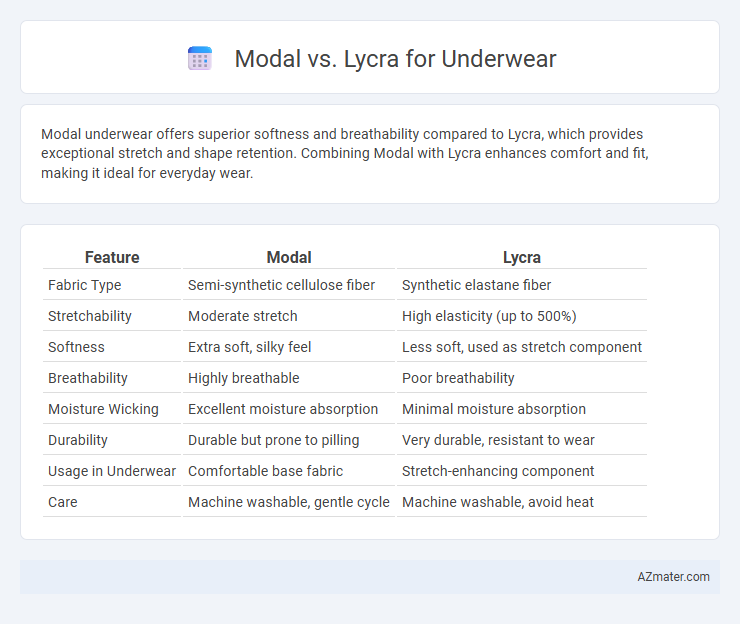Modal underwear offers superior softness and breathability compared to Lycra, which provides exceptional stretch and shape retention. Combining Modal with Lycra enhances comfort and fit, making it ideal for everyday wear.
Table of Comparison
| Feature | Modal | Lycra |
|---|---|---|
| Fabric Type | Semi-synthetic cellulose fiber | Synthetic elastane fiber |
| Stretchability | Moderate stretch | High elasticity (up to 500%) |
| Softness | Extra soft, silky feel | Less soft, used as stretch component |
| Breathability | Highly breathable | Poor breathability |
| Moisture Wicking | Excellent moisture absorption | Minimal moisture absorption |
| Durability | Durable but prone to pilling | Very durable, resistant to wear |
| Usage in Underwear | Comfortable base fabric | Stretch-enhancing component |
| Care | Machine washable, gentle cycle | Machine washable, avoid heat |
Modal vs Lycra: An Overview
Modal fabric, derived from beech tree pulp, offers superior breathability and moisture-wicking properties, making it ideal for comfortable underwear. Lycra, a synthetic elastane fiber, provides exceptional stretch and shape retention, ensuring a snug and flexible fit. Choosing between Modal and Lycra depends on the need for softness and breathability versus elasticity and durability in underwear.
Fabric Composition and Structure
Modal underwear features a semi-synthetic cellulose fiber made from beech tree pulp, offering a smooth, breathable texture with excellent moisture-wicking properties that enhance comfort. Lycra, a brand name for spandex, is a synthetic fiber known for its exceptional elasticity and recovery, often blended with cotton or polyester to provide stretch and shape retention in underwear. The structure of modal fibers is finer and softer, promoting breathability, while Lycra's molecular arrangement allows garments to conform closely to the body, ensuring flexibility and support.
Softness and Comfort Comparison
Modal fabric offers superior softness compared to Lycra, as it is made from natural beech tree fibers that feel smooth and cool against the skin. Lycra, primarily known for its exceptional elasticity, provides a snug fit but is less soft and breathable than Modal. Underwear blending Modal and Lycra achieves an optimal balance by combining Modal's comfort and softness with Lycra's stretch and shape retention.
Breathability and Moisture Management
Modal fabric offers superior breathability and moisture-wicking properties compared to Lycra, making it ideal for underwear that stays dry and comfortable throughout the day. Lycra, known for its exceptional stretch and shape retention, provides moderate breathability but does not manage moisture as effectively as Modal. Combining Modal with Lycra in underwear blends enhances both moisture management and elasticity, resulting in breathable, comfortable, and form-fitting garments.
Durability and Stretch Retention
Modal fabric offers excellent durability and maintains its softness after multiple washes, making it a reliable choice for underwear that withstands everyday wear. Lycra excels in stretch retention, providing superior elasticity and shape retention that prevents sagging or deformation over time. Combining Modal with Lycra often results in underwear that balances long-lasting strength with flexible comfort.
Fit and Support in Underwear
Modal offers a smooth, breathable fabric that provides a snug yet flexible fit, enhancing comfort without constricting movement. Lycra, known for its exceptional elasticity, delivers superior support by contouring closely to the body and maintaining shape even after prolonged wear. Combining Modal with Lycra results in underwear that balances softness and stretch, ensuring both optimal fit and effective support throughout the day.
Skin Sensitivity and Hypoallergenic Properties
Modal fabric, made from beech tree pulp, is renowned for its softness and excellent breathability, making it ideal for sensitive skin prone to irritation. Lycra, a synthetic fiber known for its exceptional stretch and durability, may sometimes cause discomfort or allergic reactions in highly sensitive individuals due to its chemical composition. Modal's natural hypoallergenic properties reduce the risk of skin irritation, whereas Lycra blended garments should be chosen carefully by those with skin sensitivities.
Care and Maintenance Requirements
Modal underwear requires gentle washing in cold water and air drying to maintain its softness and prevent shrinkage, as high heat can damage the fibers. Lycra blends demand delicate care, including washing in mild detergent and avoiding fabric softeners, which can degrade the elasticity and shape retention. Both fabrics benefit from low-heat ironing or no ironing to extend the lifespan and preserve comfort.
Sustainability and Environmental Impact
Modal fabric is made from beech tree pulp, offering a biodegradable and renewable alternative to synthetic fibers, whereas Lycra is a synthetic elastane derived from petrochemicals, contributing to non-biodegradable waste. Modal production typically requires less water and energy compared to conventional cotton and synthetic fabrics, making it a more sustainable choice for eco-conscious underwear. Lycra's durability and stretch extend garment life, potentially reducing consumption, but its reliance on fossil fuels and microplastic pollution present significant environmental concerns.
Best Uses: Choosing the Right Fabric for Your Underwear
Modal fabric excels in softness and breathability, making it ideal for everyday underwear that prioritizes comfort and moisture-wicking properties. Lycra, known for its exceptional stretch and shape retention, is best suited for activewear or form-fitting underwear requiring flexibility and durability. Selecting between Modal and Lycra depends on whether comfort or performance is the primary need, ensuring that underwear matches activity levels and wear preferences.

Infographic: Modal vs Lycra for Underwear
 azmater.com
azmater.com